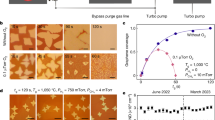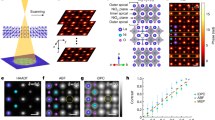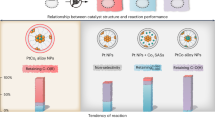Abstract
Although the oxygen reduction reaction (ORR) involves multiple proton-coupled electron transfer processes, early studies reported the absence of kinetic isotope effects (KIEs) on polycrystalline platinum, probably due to the use of unpurified D2O. Here we developed a methodology to prepare ultra-pure D2O, which is indispensable for reliably investigating extremely surface-sensitive platinum single crystals. We find that Pt(111) exhibits much higher ORR activity in D2O than in H2O, with potential-dependent inverse KIEs of ~0.5, whereas Pt(100) and Pt(110) exhibit potential-independent inverse KIEs of ~0.8. Such inverse KIEs are closely correlated to the lower *OD coverage and weakened *OD binding strength relative to *OH, which, based on theoretical calculations, are attributed to the differences in their zero-point energies. This study suggests that the competing adsorption between *OH/*OD and *O2 probably plays an important role in the ORR rate-determining steps that involve a chemical step preceding an electrochemical step (CE mechanism).

This is a preview of subscription content, access via your institution
Access options
Access Nature and 54 other Nature Portfolio journals
Get Nature+, our best-value online-access subscription
$29.99 / 30 days
cancel any time
Subscribe to this journal
Receive 12 print issues and online access
$259.00 per year
only $21.58 per issue
Buy this article
- Purchase on Springer Link
- Instant access to full article PDF
Prices may be subject to local taxes which are calculated during checkout




Similar content being viewed by others
Data availability
Source Data are provided with this paper.
References
Warburton, R. E., Soudackov, A. V. & Hammes-Schiffer, S. Theoretical modeling of electrochemical proton-coupled electron transfer. Chem. Rev. 122, 10599–10650 (2022).
Agarwal, R. G. et al. Free energies of proton-coupled electron transfer reagents and their applications. Chem. Rev. 122, 1–49 (2022).
George, T. Y., Asset, T., Avid, A., Atanassov, P. & Zenyuk, I. V. Kinetic isotope effect as a tool to investigate the oxygen reduction reaction on Pt-based electrocatalysts—part I: high-loading Pt/C and Pt extended surface. ChemPhysChem 21, 469–475 (2020).
Gómez-Marín, A. M., Rizo, R. & Feliu, J. M. Oxygen reduction reaction at Pt single crystals: a critical review. Catal. Sci. Technol. 4, 1685–1698 (2014).
Yang, Y. et al. Electrocatalysis in alkaline media and alkaline membrane-based energy technologies. Chem. Rev. 122, 6117–6321 (2022).
Bawn, C. E. H. & Ogden, G. Wave mechanical effects and the reactivity of the hydrogen isotopes. Trans. Faraday Soc. 30, 432–443 (1934).
Conway, B. E. & Steacie, E. W. R. Kinetics of electrolytic hydrogen and deuterium evolution. Proc. R. Soc. A. 256, 128–144 (1960).
Bockris, J. O. M. & Matthews, D. B. Proton tunneling in the hydrogen evolution reaction. J. Chem. Phys. 44, 298–309 (1966).
Ghoneim, M. M., Clouser, S. & Yeager, E. Oxygen reduction kinetics in deuterated phosphoric acid. J. Electrochem. Soc. 132, 1160–1162 (1985).
Tse, E. C. M., Varnell, J. A., Hoang, T. T. H. & Gewirth, A. A. Elucidating proton involvement in the rate-determining step for Pt/Pd-based and non-precious-metal oxygen reduction reaction catalysts using the kinetic isotope effect. J. Phys. Chem. Lett. 7, 3542–3547 (2016).
Chen, Y., Asset, T., Lee, R., Artyushkova, K. & Atanassov, P. Kinetic isotopic effect studies of iron–nitrogen–carbon electrocatalysts for oxygen reduction reaction. J. Phys. Chem. C 123, 11476–11483 (2019).
Mei, D. et al. Mechanistic and kinetic implications on the ORR on a Au(100) electrode: pH, temperature and H–D kinetic isotope effects. Phys. Chem. Chem. Phys. 16, 13762–13773 (2014).
Malko, D. & Kucernak, A. Kinetic isotope effect in the oxygen reduction reaction (ORR) over Fe–N/C catalysts under acidic and alkaline conditions. Electrochem. Commun. 83, 67–71 (2017).
Wang, Y. et al. Synergistic Mn–Co catalyst outperforms Pt on high-rate oxygen reduction reaction for alkaline polymer electrolyte fuel cells. Nat. Commun. 10, 1506 (2019).
Tse, E. C. M., Varnell, J. A., Hoang, T. T. H. & Gewirth, A. A. Observation of an inverse kinetic isotope effect in oxygen evolution electrochemistry. ACS Catal. 6, 5706–5714 (2016).
Conway, B. E., Angerstein-Kozlowska, H., Sharp, W. B. A. & Criddle, E. E. Ultrapurification of water for electrochemical and surface chemical work by catalytic pyrodistillation. Anal. Chem. 45, 1331–1336 (1973).
Hetland, E. Electrolytic conductivity of NaOH in H2O and of NaOD in D2O at 25°. A vacuum distilling apparatus for deuterium oxide. J. Am. Chem. Soc. 68, 2532–2535 (1946).
Sakaushi, K. Quantum proton tunneling in multielectron/-proton transfer electrode processes. Faraday Discuss. 221, 428–448 (2020).
Orts, J. M., Gomez, R., Feliu, J. M., Aldaz, A. & Clavilier, J. Potentiostatic charge displacement by exchanging adsorbed species on Pt(111) electrodes-acidic electrolytes with specific anion adsorption. Electrochem. Acta 39, 1519–1524 (1994).
Markvoic, N. M., Gasteiger, H. A. & Ross, P. N. Kinetics of oxygen reduction on Pt(hkl) electrodes: implications for the crystallite size effect with supported Pt electrocatalysts. J. Electrochem. Soc. 144, 1591–1597 (1997).
Berna, A., Climent, V. & Feliu, J. M. New understanding of the nature of OH adsorption on Pt(111) electrodes. Electrochem. Commun. 9, 2789–2794 (2007).
Arán-Ais, R. M. et al. On the behavior of the Pt(100) and vicinal surfaces in alkaline media. Electrochim. Acta 58, 184–192 (2011).
Attard, G., Souza-Garcia, J., Martínez-Hincapié, R. & Feliu, J. M. Nitrate anion reduction in aqueous perchloric acid as an electrochemical probe of Pt{110}-(1×1) terrace sites. J. Catal. 378, 238–247 (2019).
Rebollar, L., Intikhab, S., Snyder, J. D. & Tang, M. H. Kinetic isotope effects quantify pH-sensitive water dynamics at the Pt electrode interface. J. Phys. Chem. Lett. 11, 2308–2313 (2020).
Gómez-Marín, A. M., Feliu, J. M. & Ticianelli, E. Oxygen reduction on platinum surfaces in acid media: experimental evidence of a CECE/DISP initial reaction path. ACS Catal. 9, 2238–2251 (2019).
Gómez-Marín, A. M., Feliu, J. M. & Ticianelli, E. Reaction mechanism for oxygen reduction on platinum: existence of a fast initial chemical step and a soluble species different from H2O2. ACS Catal. 8, 7931–7943 (2018).
Dong, J. et al. In situ Raman spectroscopic evidence for oxygen reduction reaction intermediates at platinum single-crystal surfaces. Nat. Energy 4, 60–67 (2019).
Briega-Martos, V., Herrero, E. & Feliu, J. M. Effect of pH and water structure on the oxygen reduction reaction on platinum electrodes. Electrochim. Acta 241, 497–509 (2017).
Zhuang, L., Jin, J. & Abruña, H. D. Direct observation of electrocatalytic synergy. J. Am. Chem. Soc. 129, 11033–11035 (2007).
Gómez, R., Feliu, J. M., Aldaz, A. & Weaver, M. J. Validity of double-layer charge-corrected voltammetry for assaying carbon monoxide coverages on ordered transition metals: comparisons with adlayer structures in electrochemical and ultrahigh vacuum environments. Surf. Sci. 410, 48–61 (1998).
Rizo, R., Herrero, E. & Feliu, J. M. Oxygen reduction reaction on stepped platinum surfaces in alkaline media. Phys. Chem. Chem. Phys. 15, 15416–15425 (2013).
McCrum, I. T. & Janik, M. J. pH and Alkali cation effects on the Pt cyclic voltammogram explained using density functional theory. J. Phys. Chem. C 120, 457–471 (2016).
Nørskov, J. K. et al. Origin of the overpotential for oxygen reduction at a fuel-cell cathode. J. Phys. Chem. B 108, 17886–17892 (2004).
Hansen, H. A., Rossmeisl, J. & Nørskov, J. K. Surface Pourbaix diagrams and oxygen reduction activity of Pt, Ag and Ni(111) surfaces studied by DFT. Phys. Chem. Chem. Phys. 10, 3722–3730 (2008).
McCrum, I. T., Chen, X., Schwarz, K. A., Janik, M. J. & Koper, M. T. M. Effect of step density and orientation on the apparent pH dependence of hydrogen and hydroxide adsorption on stepped platinum surfaces. J. Phys. Chem. C 122, 16756–16764 (2018).
van der Niet, M. J. T. C., Garcia-Araeza, N., Hernández, J., Feliu, J. M. & Koper, M. T. M. Water dissociation on well-defined platinum surfaces: the electrochemical perspective. Catal. Today 202, 105–113 (2013).
Rizo, R. et al. Investigating the presence of adsorbed species on Pt steps at low potentials. Nat. Commun. 13, 2550 (2022).
Garcia-Araeza, N., Climent, V. & Feliu, J. M. Analysis of temperature effects on hydrogen and OH adsorption on Pt(111), Pt(100) and Pt(110) by means of Gibbs thermodynamics. J. Electroanal. Chem. 649, 69–82 (2010).
ASTM D1193-99e1: Standard Specification for Reagent Water (ASTM International, 1999).
Milli-Q Direct Water Purification System: Pure and Ultrapure Water Directly From Tap Water PB1032ENUS (EMD, 2020).
Amarego, W. L. F. & Perrin, D. D. in Purification of Laboratory Chemicals 4th edn (Elsevier, 1996).
Monteiro, M. C. O. & Koper, M. T. M. Alumina contamination through polishing and its effect on hydrogen evolution on gold electrodes. Electrochem. Acta 325, 134915 (2019).
Agarwal, R. Determination and application of hydrogen transfer thermochemistry: studies of molecules, nanoparticles, and metallic electrodes. PhD thesis, Univ. Yale (2021).
Clavilier, J., Faure, R., Guinet, G. & Durand, R. Preparation of monocrystalline Pt microelectrodes and electrochemical study of the plane surfaces cut in the direction of the {111} and {110} planes. J. Electroanal. Chem. 107, 205–209 (1980).
Attard, G. A. et al. The voltammetry of surfaces vicinal to Pt{110}: structural complexity simplified by CO cooling. J. Electroanal. Chem. 793, 137–146 (2017).
Rossmeisl, J., Skúlason, E., Björketun, M. E., Tripkovic, V. & Nørskov, J. K. Modeling the electrified solid–liquid interface. Chem. Phys. Lett. 466, 68–71 (2008).
Jerkiewicz, G. Standard and reversible hydrogen electrodes: theory, design, operation, and applications. ACS Catal. 10, 8409–8417 (2020).
McIntyre, J. D. E. & Salomon, M. Kinetic isotope effects in the hydrogen electrode reaction. J. Phys. Chem. 72, 2431–2434 (1968).
Lam, Y.-C., Soudackov, A. V. & Hammes-Schiffer, S. Theory of electrochemical proton-coupled electron transfer in diabatic vibronic representation: application to proton discharge on metal electrodes in alkaline solution. J. Phys. Chem. C 124, 27309–27322 (2020).
Giannozzi, P. et al. QUANTUM ESPRESSO: a modular and open-source software project for quantum simulations of materials. J. Condens. Matter Phys. 21, 395502 (2009).
Giannozzi, P. et al. Advanced capabilities for materials modelling with Quantum ESPRESSO. J. Condens. Matter Phys. 29, 465901 (2017).
Zhang, Y. & Yang, W. Comment on “Generalized gradient approximation made simple”. Phys. Rev. Lett. 80, 890–890 (1998).
Grimme, S. Semiempirical GGA-type density functional constructed with a long-range dispersion correction. J. Comput. Chem. 27, 1787–1799 (2006).
Perdew, J. P., Burke, K. & Ernzerhof, M. Generalized gradient approximation made simple. Phys. Rev. Lett. 77, 3865–3868 (1996).
Dal Corso, A. Pseudopotentials periodic table: From H to Pu. Comput. Mater. Sci. 95, 337–350 (2014).
Methfessel, M. & Paxton, A. T. High-precision sampling for Brillouin-zone integration in metals. Phys. Rev. B 40, 3616–3621 (1989).
Liu, S., White, M. G. & Liu, P. Mechanism of oxygen reduction reaction on Pt(111) in alkaline solution: importance of chemisorbed water on surface. J. Phys. Chem. C 120, 15288–15298 (2016).
Anderson, A. B., Uddin, J. & Jinnouchi, R. Solvation and zero-point-energy effects on OH(ads) reduction on Pt(111) electrodes. J. Phys. Chem. C 114, 14946–14952 (2010).
Sakong, S., Naderian, M., Mathew, K., Hennig, R. G. & Groß, A. Density functional theory study of the electrochemical interface between a Pt electrode and an aqueous electrolyte using an implicit solvent method. J. Chem. Phys. 142, 234107 (2015).
Kristoffersen, H. H., Vegge, T. & Hansen, H. A. OH formation and H2 adsorption at the liquid water–Pt(111) interface. Chem. Sci. 9, 6912–6921 (2018).
Ditchfield, R., Hehre, W. J. & Pople, J. A. Self-consistent molecular-orbital methods. IX. An extended Gaussian-type basis for molecular-orbital studies of organic molecules. J. Chem. Phys. 54, 724–728 (1971).
Hehre, W. J., Ditchfield, R. & Pople, J. A. Self-consistent molecular orbital methods. XII. Further extensions of Gaussian-type basis sets for use in molecular orbital studies of organic molecules. J. Chem. Phys. 56, 2257–2261 (1972).
Hariharan, P. C. & Pople, J. A. The influence of polarization functions on molecular orbital hydrogenation energies. Theor. Chim. Acta 28, 213–222 (1973).
Francl, M. M. et al. Self-consistent molecular orbital methods. XXIII. A polarization-type basis set for second-row elements. J. Chem. Phys. 77, 3654–3665 (1982).
Frisch, M. J. et al. Gaussian 16 Rev. C.01 (Wallingford, 2016).
Scalmani, G. & Frisch, M. J. Continuous surface charge polarizable continuum models of solvation. I. General formalism. J. Chem. Phys. 132, 114110 (2010).
Sakong, S., Naderian, M., Mathew, K., Hennig, R. G. & Groß, A. Density functional theory study of the electrochemical interface between a Pt electrode and an aqueous electrolyte using an implicit solvent method. J. Chem. Phy. 142, 234107 (2015).
NIST Chemistry WebBook: NIST Standard Reference Database Number 69 (eds. Lindstrom, P. J. & Mallard, W. G.) (National Institute of Standards and Technology, 2022).
Acknowledgements
This work was primarily supported by the Center for Alkaline-Based Energy Solutions (CABES), part of the Energy Frontier Research Center (EFRC) program supported by the US Department of Energy, under grant no. DE-SC-0019445. R.G.A. and J.M.M. acknowledge funding from the Molecular Electrochemistry Multi-University Research Initiative (MURI) supported by the US Air Force Office of Scientific Research, under grant nos. FA9550-18-1-0420; the US National Science Foundation award no. CHE-1904813 for support; and a supplement that supported R.G.A’s visit to the Koper laboratory in Leiden. P.H. and R.G. A acknowledge support from National Science Foundation Graduate Research Fellowships. R.R, E.H and J.M.F. acknowledge funding from Ministerio de Ciencia e Innovación (Spain) under grant no. PID2019-105653GB-I00. R.G.A. would also like to thank M. Koper and the members of his laboratory for their hospitality during his short stay in Leiden, and for introducing him to the challenges of preparing high-purity D2O.
Author information
Authors and Affiliations
Contributions
Y.Y. and H.D.A. conceived the project. Y.Y. performed electrochemical measurements with help from X.L. R.R. independently verified the experimental results under the guidance of E.H. and J.M.F. R.G.A. developed the D2O purification method under the guidance of J.M.M. P.H. and A.V.S performed DFT simulations under the guidance of S.H.-S. All of the authors discussed the results and approved the manuscript.
Corresponding authors
Ethics declarations
Competing interests
The authors declare no competing interests.
Peer review
Peer review information
Nature Chemistry thanks Henrik Kristoffersen, Vojislav Stamenkovic and the other, anonymous, reviewer(s) for their contribution to the peer review of this work.
Additional information
Publisher’s note Springer Nature remains neutral with regard to jurisdictional claims in published maps and institutional affiliations.
Extended data
Extended Data Fig. 1 A simplified mechanisms proposed for the oxygen reduction reaction (ORR) in acid.
Reaction pathways have been established based on extensive studies on Pt surfaces and may be applicable to other types of catalysts. A superscript * by an intermediate indicates a reaction intermediate adsorbed on the electrocatalytic surface. The CE mechanism in acid, marked in green, represents a fast surface chemical reaction preceding an irreversible one−electron transfer process. PCET stands for proton-coupled electron transfer process. H2O serves as the proton donor in alkaline media. Solution species were not included for simplicity. Complete ORR mechanisms in acid and base can be found in Supplementary Fig. 5.
Extended Data Fig. 2 Comparisons of ORR polarization profiles of three low-index Pt single crystals in acidic H2O and D2O.
Comparisons of ORR polarization profiles of three low-index Pt single crystals in O2-saturated 0.1 M HClO4 in H2O (A) and D2O (B).
Extended Data Fig. 3 Potential axis.
Potential axis showing that the RDeE is equal to the RHE in acid (for example 0.1 M HClO4, pH = 1) but is more negative than the RHE by 51 mV in base (for example 0.1 M NaOH, pH = 13) due to due to the difference in pKa in H2O (14) and D2O (14.87).
Extended Data Fig. 4 Tafel plots of Pt(111) and *OD/*OH adsorption coverage in base.
Supplementary information
Supplementary Information
Supplementary Notes, Figs. 1–6, Tables 1–11, equations 1–3 and refs. 73–77.
Source data
Source Data Fig. 1
Associated Source Data.
Source Data Fig. 2
Associated Source Data.
Source Data Fig. 3
Associated Source Data.
Source Data Fig. 4
Associated Source Data.
Source Data Extended Data Fig. 2
Associated Source Data.
Source Data Extended Data Fig. 4
Associated Source Data.
Rights and permissions
Springer Nature or its licensor (e.g. a society or other partner) holds exclusive rights to this article under a publishing agreement with the author(s) or other rightsholder(s); author self-archiving of the accepted manuscript version of this article is solely governed by the terms of such publishing agreement and applicable law.
About this article
Cite this article
Yang, Y., Agarwal, R.G., Hutchison, P. et al. Inverse kinetic isotope effects in the oxygen reduction reaction at platinum single crystals. Nat. Chem. 15, 271–277 (2023). https://doi.org/10.1038/s41557-022-01084-y
Received:
Accepted:
Published:
Issue Date:
DOI: https://doi.org/10.1038/s41557-022-01084-y



